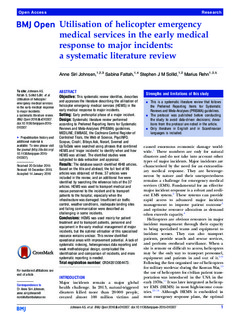| dc.description.abstract | Objective:
This systematic review identifies, describes and appraises the literature describing the utilisation of helicopter emergency medical services (HEMS) in the early medical response to major incidents.
Setting:
Early prehospital phase of a major incident.
Design:
Systematic literature review performed according to Preferred Reporting Items for Systematic Reviews and Meta-Analyses (PRISMA) guidelines. MEDLINE, EMBASE, the Cochrane Central Register of Controlled Trials, the Web of Science, PsycINFO, Scopus, Cinahl, Bibsys Ask, Norart, Svemed and UpToDate were searched using phrases that combined HEMS and ‘major incidents’ to identify when and how HEMS was utilised. The identified studies were subjected to data extraction and appraisal.
Results:
The database search identified 4948 articles. Based on the title and abstract, the full text of 96 articles was obtained; of these, 37 articles were included in the review, and an additional five were identified by searching the reference lists of the 37 articles. HEMS was used to transport medical and rescue personnel to the incident and to transport patients to the hospital, especially when the infrastructure was damaged. Insufficient air traffic control, weather conditions, inadequate landing sites and failing communication were described as challenging in some incidents.
Conclusions:
HEMS was used mainly for patient treatment and to transport patients, personnel and equipment in the early medical management of major incidents, but the optimal utilisation of this specialised resource remains unclear. This review identified operational areas with improvement potential. A lack of systematic indexing, heterogeneous data reporting and weak methodological design, complicated the identification and comparison of incidents, and more systematic reporting is needed. | nb_NO |

